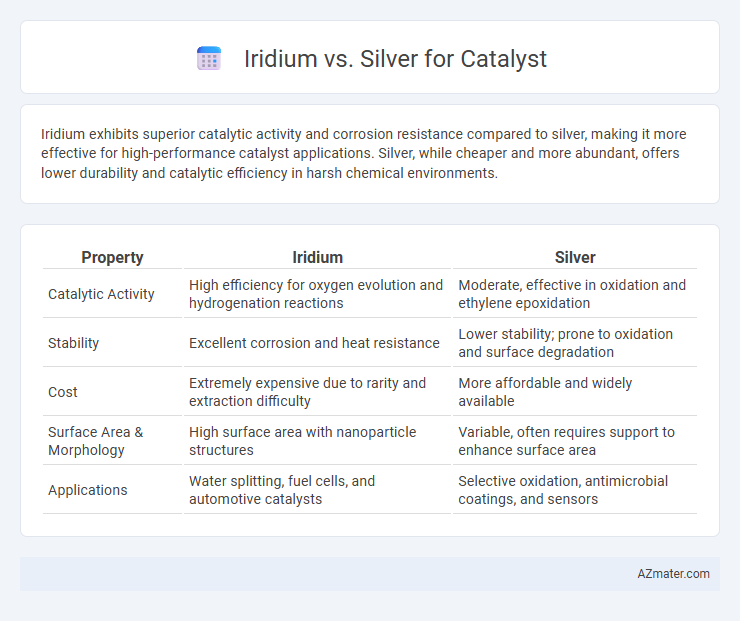Iridium exhibits superior catalytic activity and corrosion resistance compared to silver, making it more effective for high-performance catalyst applications. Silver, while cheaper and more abundant, offers lower durability and catalytic efficiency in harsh chemical environments.
Table of Comparison
| Property | Iridium | Silver |
|---|---|---|
| Catalytic Activity | High efficiency for oxygen evolution and hydrogenation reactions | Moderate, effective in oxidation and ethylene epoxidation |
| Stability | Excellent corrosion and heat resistance | Lower stability; prone to oxidation and surface degradation |
| Cost | Extremely expensive due to rarity and extraction difficulty | More affordable and widely available |
| Surface Area & Morphology | High surface area with nanoparticle structures | Variable, often requires support to enhance surface area |
| Applications | Water splitting, fuel cells, and automotive catalysts | Selective oxidation, antimicrobial coatings, and sensors |
Introduction to Iridium and Silver Catalysts
Iridium catalysts exhibit exceptional stability and performance in high-temperature and acidic environments, making them ideal for oxygen evolution reactions and other electrochemical processes. Silver catalysts are renowned for their high selectivity and excellent conductivity, particularly in applications such as CO2 reduction and oxygen reduction reactions. Both metals offer unique advantages, with iridium favored for durability and silver preferred for cost-effectiveness and specific catalytic activity profiles.
Chemical Properties and Structures
Iridium exhibits high corrosion resistance and exceptional catalytic activity due to its stable electronic configuration and dense atomic packing in the face-centered cubic (FCC) structure, which enhances adsorption and desorption processes in catalytic reactions. Silver, with a cubic crystal structure and a more reactive surface, offers lower catalytic efficiency but benefits from unique plasmonic properties that can enhance reaction rates under specific conditions. The chemical inertness of iridium contrasts with silver's susceptibility to oxidation, influencing catalyst longevity and performance in various chemical environments.
Catalytic Performance Comparison
Iridium exhibits superior catalytic performance compared to silver due to its higher catalytic activity and stability in reactions such as oxygen evolution and hydrogenation. Iridium catalysts demonstrate enhanced resistance to corrosion and maintain efficiency under harsh reaction conditions, making them ideal for industrial applications. Silver catalysts, while cost-effective, typically show lower catalytic efficiency and durability, limiting their use in high-demand catalytic processes.
Stability and Durability
Iridium catalysts exhibit superior stability and durability compared to silver catalysts due to their higher resistance to corrosion and oxidation under harsh reaction conditions. Iridium maintains catalytic activity over extended cycles with minimal degradation, making it ideal for applications requiring long-term operational resilience. Silver catalysts, while cost-effective, tend to degrade faster due to surface oxidation and sintering, limiting their lifespan in demanding catalytic processes.
Cost and Availability
Silver offers a significantly lower cost and higher abundance compared to iridium, making it a more economically viable choice for large-scale catalytic applications. Iridium's scarcity and high market price limit its availability and increase the overall expense of catalysts, despite its superior catalytic activity and stability. Balancing performance with budget constraints often leads industries to prefer silver for cost-sensitive catalytic processes.
Environmental Impact and Sustainability
Iridium catalysts exhibit high efficiency and durability, reducing the need for frequent replacements and minimizing metal waste, which is crucial for sustainable industrial processes. Silver catalysts, though less expensive, often require higher quantities and more frequent regeneration, leading to increased resource consumption and environmental burden. The scarcity and challenging mining impact of iridium pose environmental concerns, but its superior catalytic performance supports longer catalyst lifetimes, promoting overall sustainability compared to silver.
Applications in Industrial Processes
Iridium catalysts outperform silver in industrial processes requiring high resistance to oxidation and harsh reaction conditions, such as in the production of nitric acid and acetic acid. Silver catalysts are widely used in ethylene epoxidation due to their selectivity and cost-effectiveness, but iridium's superior durability makes it preferable for processes involving high temperatures and corrosive media. The choice between iridium and silver significantly impacts catalyst lifespan, efficiency, and overall process economics in large-scale chemical manufacturing.
Selectivity and Reaction Efficiency
Iridium catalysts demonstrate superior selectivity in hydrogenation reactions due to their ability to favor specific reaction pathways, minimizing byproduct formation compared to silver catalysts. Silver catalysts offer moderate reaction efficiency but often suffer from lower selectivity, leading to a broader distribution of products. The high atomic stability and electronic configuration of iridium contribute to enhanced catalytic activity and greater control over reaction outcomes in industrial applications.
Recent Advances and Innovations
Iridium catalysts exhibit superior performance in oxygen evolution reactions due to their high stability and activity, making them favored in water splitting technologies. Recent advances include nanostructuring iridium to maximize atom efficiency and alloying with transition metals to reduce costs while maintaining catalytic performance. Silver catalysts, although less active for oxygen evolution, have shown innovative applications in selective electrochemical reductions, prompting research into silver-based composites and surface modifications to enhance durability and reaction specificity.
Future Prospects and Research Directions
Iridium catalysts exhibit superior stability and activity in harsh reaction conditions, making them prime candidates for future developments in green hydrogen production and fuel cell technologies. Ongoing research focuses on enhancing the dispersion of iridium nanoparticles on conductive supports to reduce precious metal loading while maintaining catalytic efficiency. Silver, with its cost advantage and unique plasmonic properties, is being explored for synergistic catalyst designs and photoelectrocatalytic applications, suggesting a complementary role alongside iridium in sustainable energy conversion systems.

Infographic: Iridium vs Silver for Catalyst
 azmater.com
azmater.com